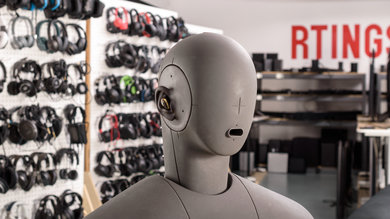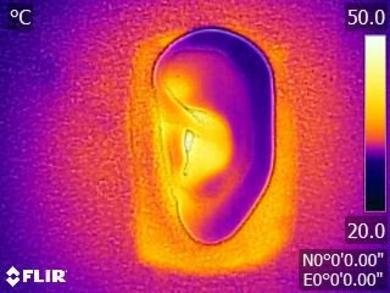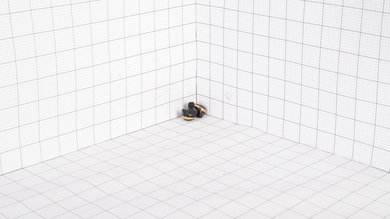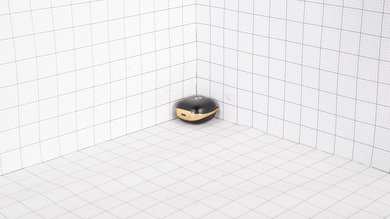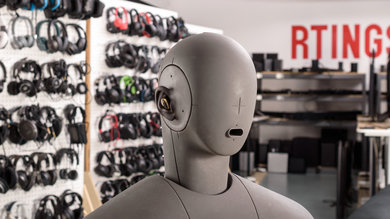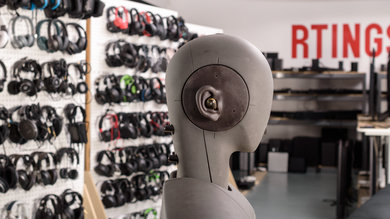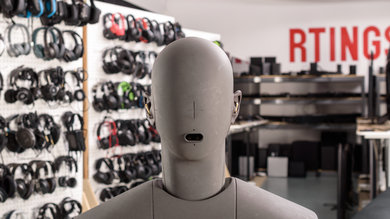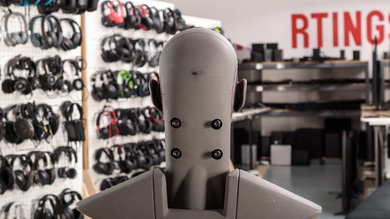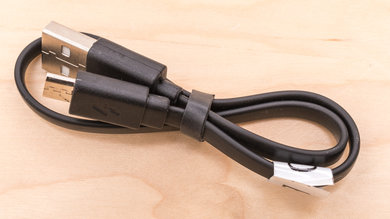The Raycon E50 Truly Wireless are unremarkable headphones. They have a very dark and boomy sound profile and don’t have any features or performance that make them stand out from the rest of the headphones on the market. They're decently well-built and are decently comfortable, but that’s about it.
Our Verdict
The Raycon E50 are okay for mixed usage. They have a boomy and dark sound profile better-suited for bass-heavy genres and won’t be great for critical listeners. Their fit also doesn’t isolate against ambient noise well. On the upside, they're portable and breathable enough for sports, but their build quality and IPX4 rating for water resistance aren't the best. Additionally, these truly wireless headphones have too much latency for watching TV or gaming without a delay.
- Decently comfortable, come with multiple tip options.
- Decently well-built design.
- Bass-heavy, boomy sound profile.
- Sub-par microphone.
- Poor noise isolation.
- Short battery life.
The Raycon E50 are mediocre for neutral sound. These headphones have a very boomy, muddy, and bass-heavy sound profile that won’t be suitable for many music genres. In-ears are also not ideal for this use as they usually aren’t the most comfortable option. If you’re looking for accurate audio reproduction to listen to your favorite tracks, the E50 aren’t the best choice.
The Raycon E50 are decent for commute and travel. They're very small and easy to carry around, thanks to their design. However, they block practically no lower-end frequencies like the rumble of a bus engine. Also, their battery life will be long enough for your commute but won’t be suitable for long flights.
The Raycon E50 are great for sports and fitness. They're stable for sports and are breathable, like most in-ears. However, they're only rated IPX4 for water resistance, which is lower than some sports-oriented headphones.
The Raycon E50 are mediocre for office use. They don’t have a very long battery life, which won’t last you for a full workday, and their sound quality is mediocre and quite bass-heavy. Their noise isolation performance is also poor and won’t be great for blocking out ambient noise. They also don’t support multi-device pairing.
Changelog
- Updated Feb 05, 2020: Converted to Test Bench 1.4.
- Updated Nov 21, 2019: Converted to Test Bench 1.3.1.
- Updated Nov 21, 2019: We've updated the Power saving feature as it turns out the auto-off timer is only when the buds are disconnected from a source.
- Updated Nov 21, 2019: Converted to Test Bench 1.3.
Check Price
Popular Headphones Comparisons

The Raycon E50 don’t necessarily set themselves apart for the right reasons. They have an unusual case design with a fully removable lid and have a boomy sound profile. They also can still play audio content in their case, meaning they won’t turn off automatically.
See our recommendations for the best true wireless earbuds, the best wireless Bluetooth earbuds under $100, and the best earbuds for bass.
The Raycon E50 Truly Wireless and the Raycon E55 Truly Wireless are very similar, but the E55 have a more bass-heavy profile, which not everyone will like. Other than that, their earbud design is the same. On the other hand, the case of the E55 has some nice improvements over the E50, like a lid that doesn't fully remove itself and wireless charging compatibility.
The Raycon E25 True Wireless are marginally better than the Raycon E50 Truly Wireless in terms of mixed usage. The E25s are more comfortable due to their size, and have much better performance in noise isolation, even boasting a longer battery life and better mic quality, but the E50 have a significantly more accurate audio reproduction, even though they sound dark and also quite bass-heavy.
The Raycon E50 Truly Wireless and the Apple AirPods (2nd generation) are completely different truly wireless headphones. The Apple are open-back so they don't isolate well. It also means they lack bass, while the Raycon have a very boomy and bass-heavy sound profile. Although the Raycon come with various tip sizes, the one-size-fits-all design of the Apple is very comfortable if they fit you. The Apple are also noticeably better built, feel more durable, and have a better battery performance with lower latency, especially with iOS devices.
The SoundPeats TrueFree/True Wireless are better truly wireless headphones than the Raycon E50 Truly Wireless. They feel slightly better-built and also have an overall better sound quality. Their fit also isolates more ambient noise than the Raycon. On the other hand, the SoundPeats lack volume controls, and they only have a standby mode instead of an auto-off timer like the Raycon. Their case also lacks a lid, which doesn't protect the headphones as much as the Raycon's case.
Test Results
The Raycon E50 are decently comfortable in-ears. They don’t enter the ear canal deeply and feel very lightweight. However, the rigid stability fin might be bothersome for some people, especially after wearing them for a while. On the upside, they come with five additional tip options, which is great. If you want a slightly more comfortable Raycon option, check out the Raycon E25 True Wireless.
The Raycon E50's control scheme is adequate and fairly straightforward. Unfortunately, it can be difficult to pair them, but once they’re paired, you shouldn’t have any issues. You can play/pause with a single tap, skip tracks or go backward with double taps, and increase/lower the volume with triple taps, which isn’t ideal. The buttons are decently clicky, and the headphones offer audible feedback as well.
The Raycon E50 come with a decent hard charging case. It has a unique lid that is completely magnetic, which means you could easily lose it as it’s not attached to the case. The case feels solid enough to protect the headphones, but the material used feels a bit cheap. On the upside, it's very small and can easily fit in pockets.
The Raycon E50 are decently well-built, truly wireless headphones. They're compact and dense enough to survive a few accidental drops without too much physical damage. However, they're made of cheap material and are prone to fingerprints due to the glossy finish. On the upside, they still feel solid and are rated IPX4 for water resistance. For slightly better-built truly wireless headphones, check out the Raycon E100 Truly Wireless.
These headphones are stable thanks to the physical fins they have. They don’t move around too much with head movement, which is great for physical activity. However, if the fit doesn’t suit you, there are no different fin size options, which you can get with different sports-oriented headphones like the Jaybird Vista Truly Wireless.
Like most in-ears, the Raycon E50 have excellent frequency response consistency. Users won’t have any issue getting a consistent sound every time they use them.
The Raycon E50's bass accuracy is okay. It lacks low-bass, making it a bit shy on the intensity of the thump and rumble. Additionally, there’s a major tilt favoring high-bass, which results in a very boomy and cluttered bass.
The Raycon E50 have a decent mid-range performance. The overemphasis in the low-mid is the continuation of the high-bass, which makes vocals and lead instruments noticeably cluttered. On the upside, the rest of the range is well-balanced and vocals and leads will have the right intensity and projection.
The Raycon E50's treble accuracy is alright. The low-treble range is fairly well-balanced, but the overall response is noticeably under our target curve, especially in higher frequencies. These headphones lack detail and brightness, and due to their boomy bass, they have a fairly dark sound profile.
The Raycon E50's stereo imaging is amazing. The group delay is under the audibility threshold, which results in tight bass and treble ranges. Also, the L/R drivers of our test unit were well-matched in frequency, amplitude, and phase response. This is important for the accurate placement and localization of objects (voices, instruments, video game effects) in the stereo image. Note that these results are only valid for our unit, and yours may perform differently.
The soundstage is poor. This is because creating an out-of-head and speaker-like soundstage is largely dependent on activating the resonances of the pinna (outer ear). The design of in-ears and earbuds is in such a way that fully bypasses the pinna and doesn't interact with it. Also, because these headphones have a closed-back enclosure, their soundstage won't be perceived to be as open as that of open-back earbuds like the Apple AirPods (2nd generation) Truly Wireless, the Google Pixel Buds 2017 Wireless, or the Bose SoundSport Free Truly Wireless.
The Raycon E50's noise isolation is sub-par. They don’t isolate in the bass range, making them a sub-par option for commuting if you’re looking to block out the deep rumble of a bus or plane engine. They do a decent job against mid-range noises like ambient chatter, which means they can be used in an office setting. They also do a good job blocking out treble frequencies like sharp S and T sounds and the noise coming from an A/C system.
The Raycon E50's leakage performance is excellent. Like most in-ears, most of the leakage is in the higher frequencies, making it sound a bit thin. However, the leakage isn’t loud and won’t be very audible, unless you’re blasting your music in a very quiet environment.
The recording quality of the Raycon E50's integrated microphone is poor. Speech recorded or transmitted with this integrated microphone feels muffled and lacking in detail. Speech is understandable in very quiet environments, but the audio quality is poor.
The Raycon E50's integrated microphone is sub-par. It has trouble separating ambient noise and actual recorded speech, meaning it's quite hard to understand speech when in a moderately loud environment like a busy street. The Raycon E50 are better-suited for very quiet environments.
Update 11/15/2019:The Raycon E50's turn off automatically after eight minutes of not being connected with a device. They don't have a smart power-saving feature to save battery when no content is being played and the buds are still connected to your device. The text and the review have been updated.
The Raycon E50 have just under four hours of continuous playback with a single charge, which is slightly disappointing. Weirdly enough, the buds were still playing content when placing them in the case, so be sure to turn them off. You can also use any bud while the other is charging, and the case holds about four extra charges.
There's no dedicated companion app for the Raycon E50.
The Raycon E50 are Bluetooth 5.0 compatible, but can’t connect to multiple devices simultaneously, which could have been useful at the office if you often switch between a PC and your phone. Also, they don’t support NFC pairing for a quicker and easier pairing procedure, which would have been nice considering the difficulties we had pairing them sometimes.
The Raycon E50 come with a hard charging case that can recharge the headphones. They hold the equivalent of about four extra charges according to the manufacturer. You can power the case with the included USB to micro-USB cable.

